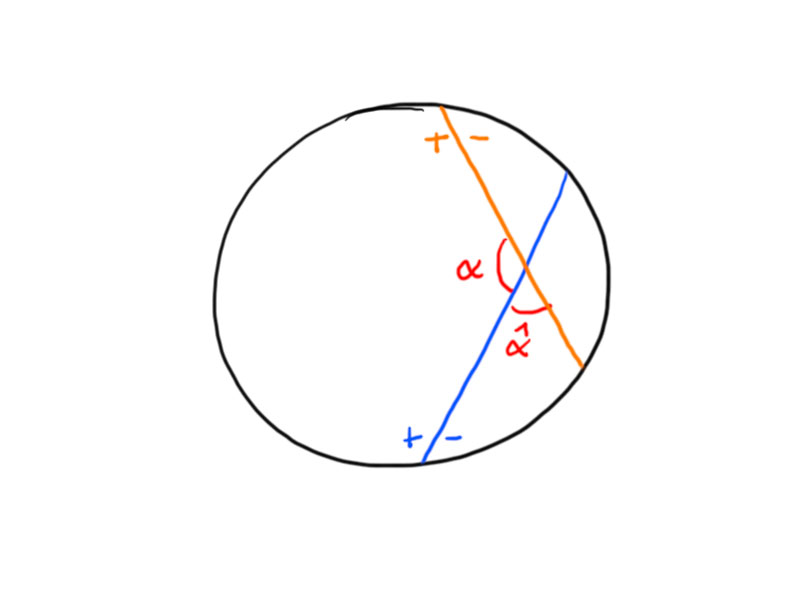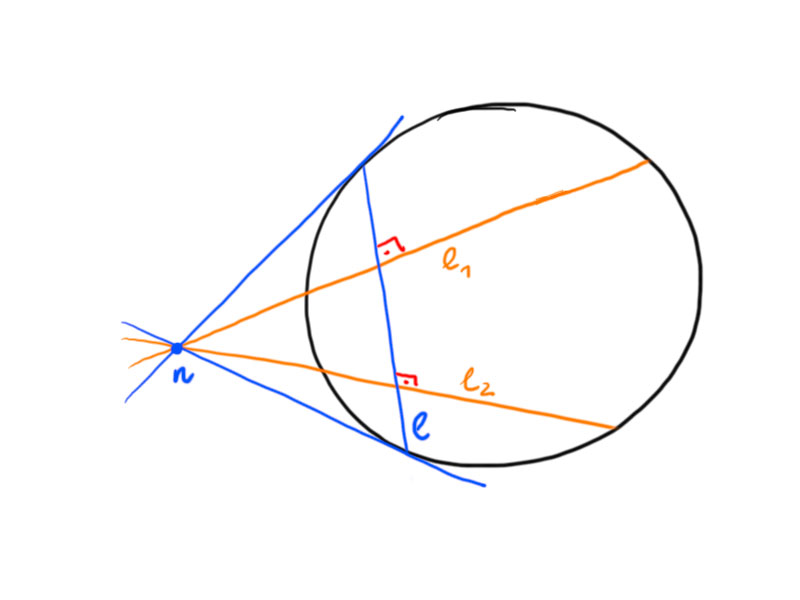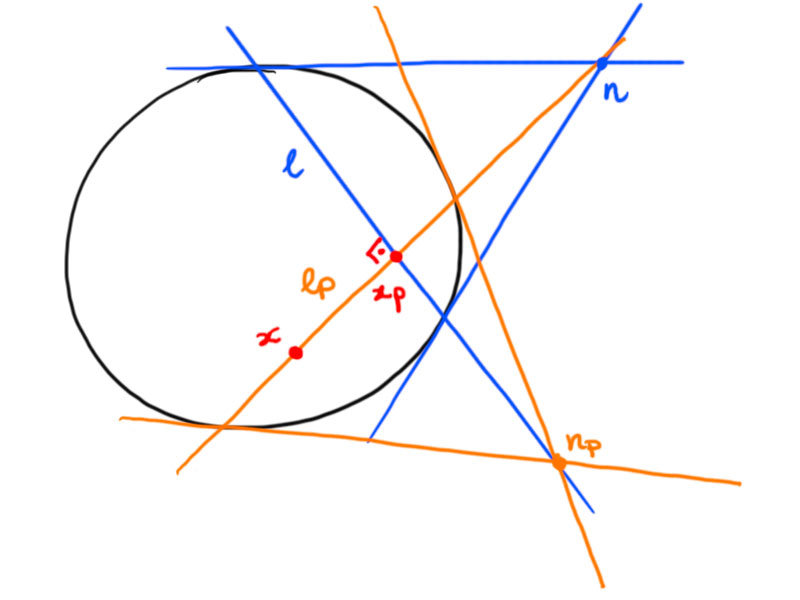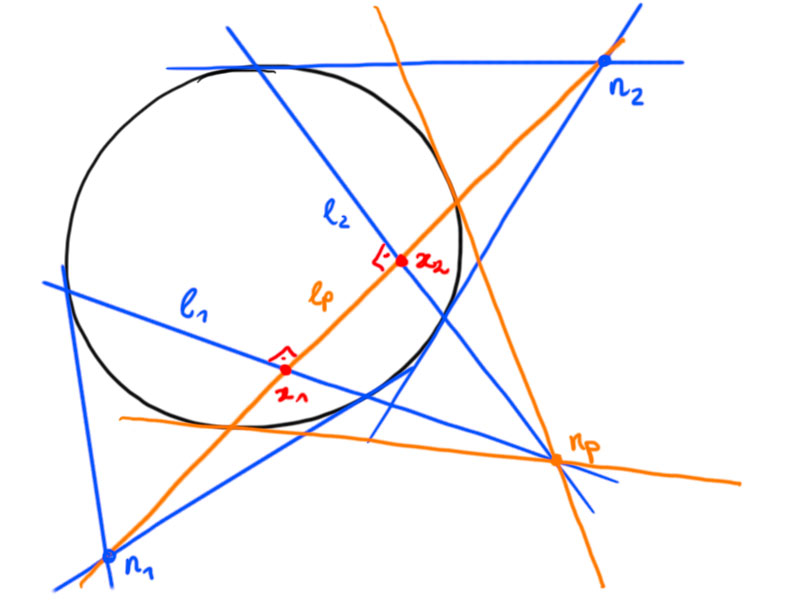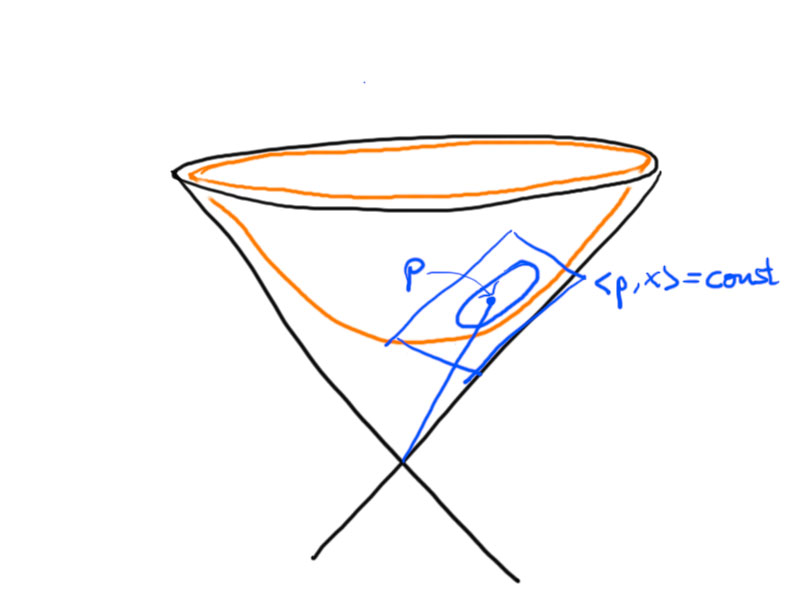Definition.
Let $\ell_1$, $\ell_2$ be two intersecting lines defined by unit normals $n_1$, $n_2$.
The exterior angle $\hat\alpha$ of these two lines is given by
\[\cos\hat\alpha=\langle n_1,n_2\rangle\,.\]
The interior angle $\alpha=\pi-\hat\alpha$ is given by
\[\cos\alpha=-\langle n_1,n_2\rangle\,.\]
In particular, two lines are perpendicular, if $\langle n_1,n_2\rangle=0$.
Remark.
The Euclidean angle of intersection differs from the hyperbolic angle defined above.
Example
I don’t remember the example 🙁
Proposition
- Given $x\in H^2$ and a line $\ell\subset H^2$, there exists a unique line through $x$ perpendicular to $\ell$.
- If $\ell_1,\ell_2\in H^2$ are two non-intersecting lines ($\lvert \langle n_1,n_2\rangle\rvert >1$), then there exists a unique line perpendicular to $\ell_1$ and $\ell_2$.
Proof. Homework.
Let $\ell_1,\ell_2\in H^2$ be two hyperbolic lines with unit normal vectors $n_1$, $n_2$:
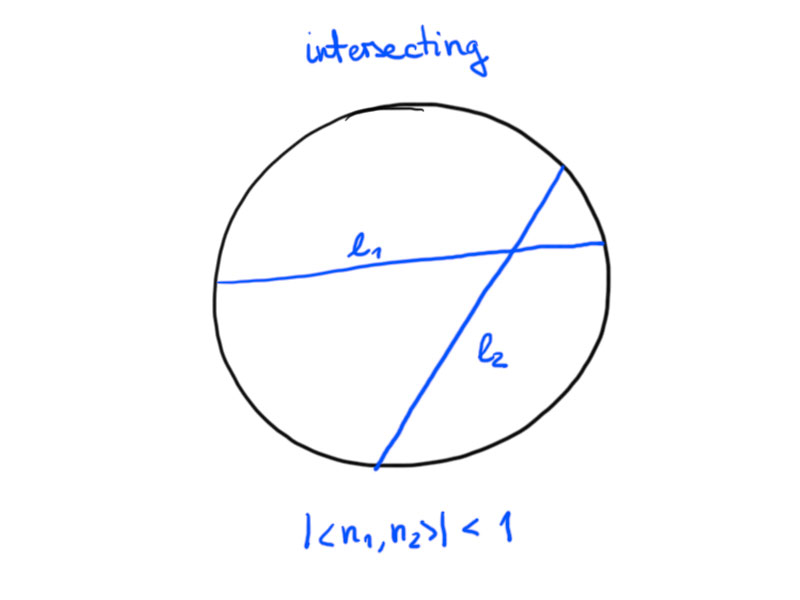
If $\lvert \langle n_1,n_2\rangle\rvert < 1$, then $\ell_1$ and $\ell_2$ intersect.
If $\lvert \langle n_1,n_2\rangle\rvert = 1$, we call $\ell_1$ and $\ell_2$ parallel.
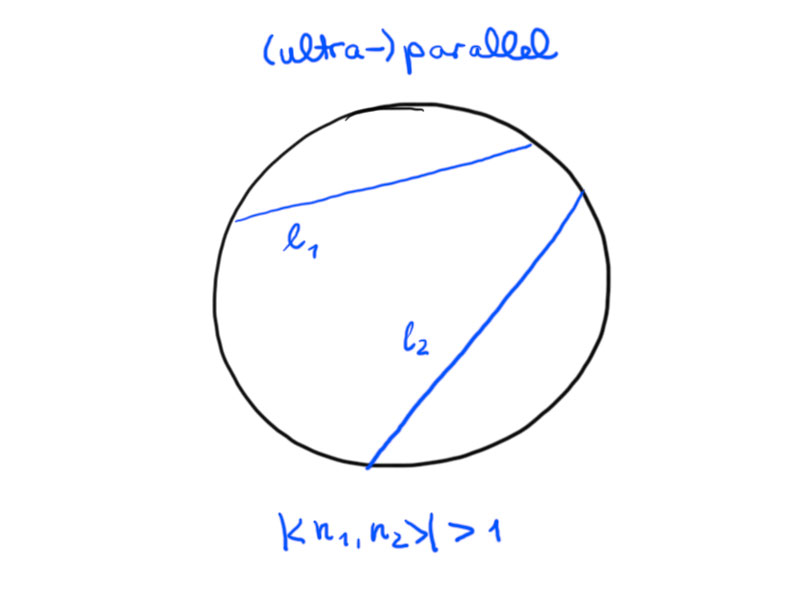
If $\lvert \langle n_1,n_2\rangle\rvert >1$, we call $\ell_1$ and $\ell_2$ (ultra-)parallel.
Distances in the hyperbolic plane
Proposition
The point on a line $\ell\subset H^2$ closest to a point $x\in H^2$ is the intersection point of $\ell$ with its unique perpendicular line through $x$.
Proof.
W.l.o.g. assume $x\notin\ell$.
We have
\begin{align*}
\langle n_p,x\rangle&=\langle n_p,x_p\rangle=0&
\langle n,x_p\rangle&=0&
\langle n_p,n\rangle&=0\,.
\end{align*}
We normalize $n_p$ and $x_p$ such that $\langle n_p,n_p\rangle=1$ and $\langle x_p,x_p\rangle=-1$.
Now $\gamma(s)=\cosh(s)x_p+\sinh(s)n_p$ is an arclength parametrization of $\ell$.
The distance from $x$ to $\gamma(s)$ is
\[\cosh d(x,\gamma(s))=-\langle x,\gamma(s)\rangle=-\langle x,\cosh(s)x_p\rangle-\langle x,\sinh(s)n_p\rangle=-\cosh(s)\langle x,x_p\rangle\,.\]
This is minimal for $s=0$, $\gamma(0)=x_p$.
Thus the closest point is $x_p$.
Proposition
- For the distance of a point $x\in H^2$ to a line $\ell\subset H^2$ defined by a unit normal $n$, we have
\[\sinh d(x,\ell)=\lvert \langle x,n\rangle\rvert \,,\]
where $d(x,\ell)=d(x,x_p)$ and $x_p$ is closest to $x$ on $\ell$. - The distance between two non-intersecting lines $\ell_1,\ell_2\subset H^2$ with unit normals $n_1$, $n_2$ is
\[\cosh d(\ell_1,\ell_2)=\lvert \langle n_1,n_2\rangle\rvert\,,\]
where $d(\ell_1,\ell_2)$ is the minimal distance of two points on $\ell_1$, $\ell_2$, resp., or $d(\ell_1,\ell_2)=d(x_1,x_2)$, where $x_i=\ell_i\cap\ell_p$ and $\ell_p\perp\ell_1,\ell_2$.
Proof.
(i). Consider the arclength parametrization
\[\gamma_p(s)=\cosh(s)x_p+\sinh(s)n\]
of $\ell_p$.
Now
\[x=\gamma_p(s_0)\quad\text{with}\quad s_0=\pm d(x,x_p)\,.\]
Thus
\[\lvert \langle n,x\rangle\rvert =\lvert \langle n,\cosh(s_0)x_p+\sinh(s_0)n\rangle\rvert =\lvert \sinh(s_0)\rvert \,,\]
as $n$ is normalized to $\langle n,n\rangle=1$.
This yields
\[\sinh d(x,\ell)=\sinh d(x,x_p)=\lvert \langle n,x\rangle\rvert \,.\]
(ii). Parametrize $\ell_1$ as follows:
\[\gamma_1(s)=\cosh(s)x_1+\sinh(s)n_p\,.\]
The distance of $\gamma_1(s)$ to $\ell_2$ is
\[\sinh d(\gamma(s),\ell_2)=\lvert \langle \gamma_1(s),n_2\rangle\rvert =\cosh(s)\lvert \langle x_1,n_2\rangle\rvert \]
since $\langle n_2,n_p\rangle=0$.
This is minimal for $s=0$, i.e. $x_1$ is closest to $\ell_2$ on $\ell_1$
Similarly, $x_2$ is the point closest to $\ell_1$ on $\ell_2$.
Now parametrize $\ell_p$.
\begin{align*}
x_1&=\cosh(s_0)x_2+\sinh(s_0)n_2&
x_2&=\cosh(\tilde s_0)x_1+\sinh(\tilde s_0)n_1\,.
\end{align*}
Here, $s_0=\pm d(x_1,x_2)=\pm\tilde s_0$.
Thus with $\langle n_1,n_1\rangle=1$
\begin{align*}0
&=\langle n,x_1\rangle=\cosh(s_0)\langle n_1,x_2\rangle+\sinh(s_0)\langle n_1,n_2\rangle=\cosh(s_0)\sinh(\tilde s_0)+\sinh(s_0)\langle n_1,n_2\rangle\\
&=\sinh(s_0)(\cosh(s_0)\pm\langle n_1,n_2\rangle)
\end{align*}
and hence $\cosh d(\ell_1,\ell_2)=\lvert \langle n_1,n_2\rangle\rvert $.
Intersections of $H^2$ with planes
Definition.
An affine plane is determined by one equation
\[\langle n,x\rangle_{2,1}=b\]
where $n\in\R^{2,1}$, $n\neq0$, and $b\in\R$.
Let $n$ be time-like, $\langle n,n\rangle < 0$.
If $\langle n,n\rangle=-1$, then $n\in H^2$ and $-\langle n,x\rangle=\cosh d(x,n)$ shall be equivalent to $\langle n,x\rangle=b$, i.e. the intersection of the plane given by $\langle n,x\rangle=b$ is a hyperbolic circle around $n$ with radius $r$ such that $\cosh r=-b$ ($b<0$).
What are the sets defined by space-like and isotropic normal vectors?

